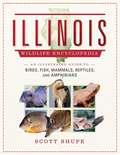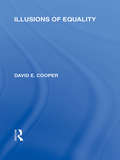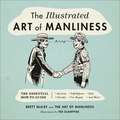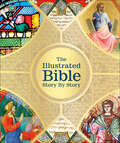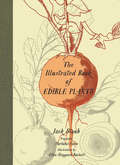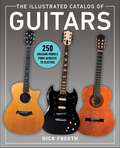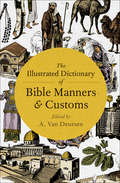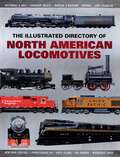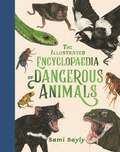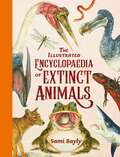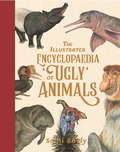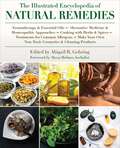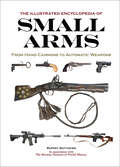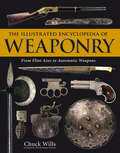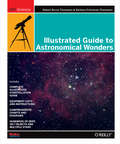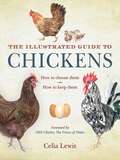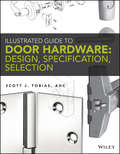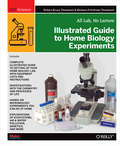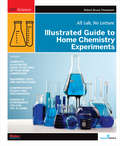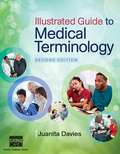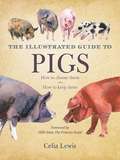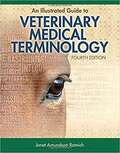- Table View
- List View
The Illinois Wildlife Encyclopedia: An Illustrated Guide to Birds, Fish, Mammals, Reptiles, and Amphibians
by Scott ShupeIllinois’s wildlife has always played an important role in the history of human beings inhabiting the state. Native Americans depended on birds, mammals, and fish for sustenance and the state’s first Europeans came in search of Beaver and buckskins. Although the state’s wildlife is still an important resource for human consumption, wildlife is also increasingly important in today’s culture for its intrinsic, aesthetic value. For many Illinoisans, the age-old traditions of hunting and fishing have been replaced by a desire to simply observe wildlife and experience nature. But most Illinoisans are largely unaware of the diversity of species inhabiting their state. This volume is intended to provide an introduction to the state’s fishes, amphibians, reptiles, birds, and mammals. In The Illinois Wildlife Encyclopedia, nationally known naturalist Scott Shupe has collected information on all the wildlife that reside in the Prairie State. The fourth volume in a series of state wildlife encyclopedias, this book will be a handy, usable, layman’s guide to Illinois’ wildlife. Included are over 800 color photographs, depicting the different species of mammals, reptiles, amphibians, birds, and fish, while also offering over 600 range maps to show their territory. Along with basic information for the biology of each animal, Shupe includes the size, habitat, and abundance of each species located in the state. Whether you’re a lover of the outdoors, photography, or are looking to learn more about your state, this comprehensive guide will teach you about the wonderful wildlife that covers the water, earth, and skies of Illinois.
Illusions of Equality (International Library Of The Philosophy Of Education)
by David CooperEducational policy and discussion, in Britain and the USA, are increasingly dominated by the confused ideology of egalitarianism. David E. Cooper begins by identifying the principles hidden among the confusions, and argues that these necessarily conflict with the ideal of educational excellence - in which conflict it is this ideal that must be preserved. He goes on to criticize the use of education as a tool for promoting wider social equality, focussing especially on the muddles surrounding 'equal opportunities', 'social mix' and 'reverse discrimination'. Further chapters criticize the 'new egalitarianism' favoured, on epistemological grounds, by various sociologists of knowledge in recent years and 'cultural egalitarianism' according to which standard criteria of educational value merely reflect parochial and economic interests.
The Illustrated Art of Manliness: Survival Chivalry Self-Defense Style Car Repair And More!
by Brett Mckay Ted SlampyakAn indispensable, hands-on guide dedicated to the lost art of being a man, The Illustrated Art of Manliness distills more than 100 practical skills every modern man needs to know into an entertaining, easy-to-follow visual format. Founder of The Art of Manliness Brett McKay and bestselling illustrator Ted Slampyak write brilliantly illustrated articles to help men be the best fathers, brothers, sons, and men they can be. This book features their most essential work alongside dozens of never-before seen guides on subjects ranging from chivalry and self-defense to courage and car repair, including: How to disarm an attacker How to fell a tree and start a fire anywhere How a car engine works, and how to fix it How to use every tool in your toolbox What to wear on a first date and to a job interview How to lead a meeting and command the attention of a room How to dance, fight, shave, shake a hand, pick a lock, and fire a gun And other advice for when you're lost, in danger, or merely confronting a shirt that needs to be ironed. The Illustrated Art of Manliness features a classic, timeless package, including full-color illustrations, and will be a perfect gift for you or the man in your life.
The Illustrated Bible Story by Story (DK Bibles and Bible Guides)
by DKThe greatest story ever told is explored and explained in unprecedented detail inside this spectacular illustrated family Bible. This indispensable best-selling Bible incorporates the history of the book, the Old Testament, the New Testament, and a special section on Biblical people and places. The stories are retold by experts from all denominations, resulting in an absorbing volume designed to educate and entertain readers, young and old. Key figures are also introduced, from Adam and Abraham to Peter and Paul, while important sites, such as Jericho, Jerusalem, and Mount Sinai, are depicted alongside photographs and specially commissioned maps to truly set the scene. All the most important episodes are brought to life with beautiful illustrations, works of art, historical artifacts, and pull-out quotations. The Illustrated Bible takes an innovative and inspiring visual approach to this classic book, resulting in the only reference you&’ll ever need for the whole family.
The Illustrated Book of Edible Plants
by Jack StaubHistories, medicinal uses, and recipe ideas for food plants from A to Z—illustrated with beautiful watercolor art. Focusing on the most growable vegetables, herbs, and fruits for the greatest number of people, Jack Staub tells the stories of their origins and apprises the home gardener on ways to use them, from the table to remedies and potions. Up-to-the-minute cultivation and culinary advice are delivered with accessibility and wit, as well as tidbits of folkore and myth that surround these plants, from the author of 75 Exciting Vegetables for Your Garden, 75 Remarkable Fruits for Your Garden, and 75 Exceptional Herbs for Your Garden.
The Illustrated Catalog of Guitars: 250 Amazing Models From Acoustic to Electric
by Nick FreethA must-have for any guitar lover!This book introduces the reader to 250 guitars of all types from the early acoustic archtop designs of the Gibson L-5 in the last 1920s, through the National resonators of the 1930s, the hollow body electric Gibsons of the 1950s, the solid body Fenders of the 1960s, to the exoskeletal carbon and glass fiber of the Parker Fly of the 1990s. Each entry has a clear color photograph of the guitar together with a detail shot featuring a point of particular interest of that instrument along with a description and a technical specification. It is arranged in alphabetical order by maker&’s name and coded by the type of guitar. The guitar had a profound influence on many musical forms including blues, bluegrass, country, flamenco, jazz, folk, heavy metal, rock, soul, reggae, and modern pop.
The Illustrated Dictionary of Bible Manners & Customs
by A. Van DeursenThis comprehensive volume provides detailed descriptions, illustrations, and context for many of the Bible&’s historical and cultural references. Bible stories are full of objects, manners, and customs that would have been easily recognized by people living in the Middle East during ancient times. Towns have their walls and gates; agriculture has its threshing instruments and carts; the tabernacle has its altars and lavers of brass. But while the terms used to describe these items were once common knowledge, they leave many modern readers wondering about their specific meanings. This volume offers a clearer understanding of the Bible through accessible information about its many historical references. Organized by subject matter, it includes chapters on everything from vegetation to coinage, matrimony, weaponry, transportation, idolatry, and holy places, among many other topics. Based on archeological research, The Illustrated Dictionary of Bible Manners & Customs helps readers attain a more vivid sense of the Bible&’s rich background and longstanding influence.
The Illustrated Dictionary of Greek and Roman Mythology
by Michael StapletonAn outstanding reference for mythology study.
Illustrated Dictionary of Photography
by Michelle Perkins Barbara A Lynch-JohntCataloging everything from historic photographic processes to the latest advances in digital technology, this reference contains nearly 5,000 entries explaining the terms and techniques of photography. An ideal sourcebook for anyone with an interest in photography, entries include words associated with shooting techniques, digital imaging terms, specialized photographic subgenres, the science of photography, and notable photographers. Each entry blends ample cross-references with detailed explanations to provide both professional photographers and amateur photo enthusiasts with an essential resource.
The Illustrated Directory of North American Locomotives: The Story and Progression of Railroads from The Early Days to The Electric Powered Present
by Pepperbox PressMore than 250 classic American locomotives."Let the country but make the railroads, and the railroads will make the country." — Edward PeaseDuring the mid-1800s, American railroads became the lifeblood of new communities in the West and brought new ways of life and means of commerce to rural communities. Railroads became the shining thread that tied together the tapestry of American life into a land of plenty. The Illustrated Dictionary of North American Locomotives explores the story of railroads and their motive power. Giant beasts of iron and steel once roamed the land. Their descendants still race across the country.This book charts the progress of motive power on America's railroads from 1830 until the present. Its 432 pages illustrate a wide variety of grand and humble locomotives from the steam powered Puffing Billy types of the "Early Days" chapter, to the mighty Allegheny class steamers that were used to haul coal for the American industry in the "Steam in Charge" chapter. Technical specifications are given for each engine type and the book is fully illustrated with both black & white and color photos. The book goes on to show the progress of Diesel Power, including the output of General Electric and General Motors electromotive division (EMD) from the 1920s to the present. Ultimately, the book also explores the Electric Power that powers so many of today's railways.
The Illustrated Encyclopaedia of Dangerous Animals
by Sami BaylyDiscover more than 60 of the world's most dangerous animals and the facts behind their bad reputations, including the highly venomous Brazilian wandering spider and the truly terrifying Tasmanian Devil.The Illustrated Encyclopaedia of Dangerous Animals is a fascinating compendium of the strange and the dangerous of the animal kingdom. Did you know that African buffaloes have good memories and have been known to attack people who have hurt them in the past? And that piranha fish can smell a single drop of blood in 200 litres of water? Have you heard of the carnivorous caterpillars of Hawaii?But don't panic - these animals are not actually out to get us! They have simply evolved some amazing features to protect themselves from predators, including us humans. With detailed illustrations to pore over, curious children (and the adults in their lives) will love discovering the facts behind the bad reputations of these truly fascinating creatures.From the talented author and illustrator of The Illustrated Encyclopaedia of 'Ugly' Animals, Sami Bayly.
The Illustrated Encyclopaedia of Extinct Animals
by Sami BaylyThe Illustrated Encyclopaedia of Extinct Animals is a fascinating compendium of the strange and wonderful animals that once roamed our Earth. From the well-known woolly mammoth and sabre-toothed tiger to the laughing owl said to cackle like a madman, discover more about these incredible lost species. Children and adults alike will pore over the breathtaking scientific illustrations and unusual animals, discovering why these creatures became extinct and learning about science and nature along the way.
The Illustrated Encyclopaedia of 'Ugly' Animals (The\illustrated Encyclop Ser.)
by Sami BaylyCHILDREN'S BOOK OF THE YEAR, INDIE BOOK AWARDS 2020Marvel as you enter the fascinating hidden world of ugly animals in this encyclopaedia of the animal kingdom's most unusual and and so-called 'ugly' species. It's time to see ugliness in a whole new light! With more than sixty animals to explore, this compendium of the unusual celebrates the beauty in 'ugliness'. Children and adults alike will pore over the breathtaking scientific illustrations of unusual animals, discovering why these animals developed such extraordinary features and learning about science and nature along the way. Featuring illustrations and facts about the thorniest species the animal kingdom has to offer, from the naked mole rat to the goblin shark, aye-aye, blobfish and many more. This gorgeous hardcover book is illustrated in exquisite detail by debut artist Sami Bayly.
The Illustrated Encyclopedia of Natural Remedies
by Abigail GehringMore than 100 Remedies and Recipes for Vibrant Health! Packed with step-by-step instructions to make your own herbal remedies, simple recipes for cooking with herbs and spices, and beautiful photographs, this might be the most comprehensive guide to natural remedies ever published. Here readers can learn about alternative medicine and homeopathic approaches, aromatherapy and essential oils, and much, much more. Natural Healing for Common Ailments Cooking with SuperfoodsJuices & CleansesEdible Wild Plants Planning an Herb GardenEveryday Treatments for Women & ChildrenNatural Cleansers for the HomeHomemade Non-Toxic CosmeticsRevitalizing Tinctures & ShotsAnti-Inflammatory Foods Take charge of your family's health and well-being with this comprehensive guide.
The Illustrated Encyclopedia of Small Arms: From Hand Cannons to Automatic Weapons
by Rupert MatthewsThis comprehensive, fully illustrated reference volume covers the evolution of small arms from primitive spears to portable rocket launchers.The Illustrated Encyclopedia of Small Arms details more than 1,000 weapons, complete with full-color photographs. Featuring arms from around the world and across history, this stunning guide highlights the intricacies that make each variety unique, tying in historical anecdotes as well as the history of certain brands. Revealing fascinating insights and historical episodes—such as the inspiration for Samuel L. Colt&’s revolvers, or the lozenge-case gun used by Italian spies during World War II—this is an ideal resource for historians as well as fire arms enthusiasts. The volume is lushly illustrated with detailed photographs, many of which are published here for the first time.
The Illustrated Encyclopedia of Weaponry: From Flint Axes to Automatic Weapons
by Chuck WillsA complete look at weapons—from the Stone Age and Bronze Age to present day—from spears and swords to handguns and automatic weapons.When did hunting weapons begin to be used against humans instead of animals? What is the difference between the Plains Indian War Club and the Fijian War Club? What weapon is common to peoples in every part of the world? The Illustrated Encyclopedia of Weaponry is a comprehensive guide to arms and armaments throughout history.Beginning in the Stone Age, The Illustrated Encyclopedia of Weaponry travels through the Bronze Age to our present day, showing the tools humans have used to defend themselves all around the globe. There&’s the Japanese tanto, or dagger, which have become identified with gangs known as yakuza. There&’s the flaming arrow used when Swiss and Austrian forces clashed in the 14th century. And there&’s the revolver that Samuel Colt made practical for both military and civilian use in Hartford, Connecticut.The Illustrated Encyclopedia of Weaponry will help readers better understand how—and why—the battles of history were fought.
Illustrated Guide to Astronomical Wonders: From Novice to Master Observer
by Robert Bruce Thompson Barbara Fritchman ThompsonWith the advent of inexpensive, high-power telescopes priced at under $250, amateur astronomy is now within the reach of anyone, and this is the ideal book to get you started. The Illustrated Guide to Astronomical Wonders offers you a guide to the equipment you need, and shows you how and where to find hundreds of spectacular objects in the deep sky -- double and multiple stars as well as spectacular star clusters, nebulae, and galaxies.You get a solid grounding in the fundamental concepts and terminology of astronomy, and specific advice about choosing, buying, using, and maintaining the equipment required for observing. The Illustrated Guide to Astronomical Wonders is designed to be used in the field under the special red-colored lighting used by astronomers, and includes recommended observing targets for beginners and intermediate observers alike. You get detailed start charts and specific information about the best celestial objects.The objects in this book were chosen to help you meet the requirements for several lists of objects compiled by The Astronomical League.Binocular Messier ClubUrban Observing ClubDeep Sky Binocular ClubDouble Star ClubRASC Finest NGC ListCompleting the list for a particular observing club entitles anyone who is a member of the Astronomical League or RASC to an award, which includes a certificate and, in some cases, a lapel pin.This book is perfect for amateur astronomers, students, teachers, or anyone who is ready to dive into this rewarding hobby. Who knows? You might even find a new object, like amateur astronomer Jay McNeil. On a clear cold night in January 2004, he spotted a previously undiscovered celestial object near Orion, now called McNeil's Nebula. Discover what awaits you in the night sky with the Illustrated Guide to Astronomical Wonders.
The Illustrated Guide to Chickens: How to Choose Them, How to Keep Them
by Celia Lewis HRH The Prince Charles Prince Of WalesChickens are fun, useful, and easy to keep. If you have ever considered raising your own backyard flock, The Illustrated Guide to Chickens is the book for you! It offers practical advice and contains all the information you need to choose from one of the 100 most familiar breeds of chicken in North America and Europe to raise. Each breed's profile is written in engaging text that covers its history and main characteristics. You'll also find practical advice about poultry rearing and husbandry and the pros and cons of pure breeds, hybrids, bantams, game foul, and the like.
Illustrated Guide to Door Hardware: Design, Specification, Selection
by Scott TobiasYour one-stop, comprehensive guide to commercial doors and door hardware--from the brand you trust Illustrated Guide to Door Hardware: Design, Specification, Selection is the only book of its kind to compile all the relevant information regarding design, specifications, crafting, and reviewing shop drawings for door openings in one easy-to-access place. Content is presented consistently across chapters so professionals can find what they need quickly and reliably, and the book is illustrated with charts, photographs, and architectural details to more easily and meaningfully convey key information. Organized according to industry standards, each chapter focuses on a component of the door opening or door hardware and provides all options available, complete with everything professionals need to know about that component. When designing, specifying, creating, and reviewing shop drawings for door openings, there are many elements to consider: physical items, such as the door, frame, and hanging devices; the opening's function; local codes and standards related to fire, life safety, and accessibility; aesthetics; quality and longevity versus cost; hardware cycle tests; security considerations; and electrified hardware requirements, to name a few. Until now, there hasn't been a single resource for this information. The only resource available that consolidates all the door and hardware standards and guidelines into one comprehensive publication Consistently formatted across chapters and topics for ease of use Packed with drawings and photographs Serves as a valuable study aid for DHI's certification exams If you're a professional tired of referring to numerous product magazines or endless online searches only to find short, out-of-date material, Illustrated Guide to Door Hardware: Design, Specification, Selection gives you everything you need in one convenient, comprehensive resource.
Illustrated Guide to Home Biology Experiments: All Lab, No Lecture
by Robert Bruce Thompson Barbara Fritchman ThompsonExperience the magic of biology in your own home lab. This hands-on introduction includes more than 30 educational (and fun) experiments that help you explore this fascinating field on your own. Perfect for middle- and high-school students and DIY enthusiasts, this full-color guide teaches you the basics of biology lab work and shows you how to set up a safe lab at home.The Illustrated Guide to Home Biology Experiments is also written with the needs of homeschoolers firmly in mind, as well as adults who are eager to explore the science of nature as a life-long hobby. To get the most from the experiments, we recommend using this guide in conjunction with a standard biology text, such as the freely downloadable CK-12 Biology (ck-12.org).Master the use of the microscope, including sectioning and stainingBuild and observe microcosms, soda-bottle worlds of pond lifeInvestigate the chemistry of life from simple acids, bases, and buffers to complex carbohydrates, proteins, lipids, enzymes, and DNAExtract, isolate, and observe DNAExplore photosynthesis, osmosis, nitrogen fixation, and other life processesInvestigate the cell cycle (mitosis and cytokinesis)Observe populations and ecosystems, and perform air and water pollution testsInvestigate genetics and inheritanceDo hands-on microbiology, from simple culturing to micro-evolution of bacteria by forced selectionGain hands-on lab experience to prepare for the AP Biology examThrough their company, The Home Scientist, LLC (thehomescientist.com/biology), the authors also offer inexpensive custom kits that provide specialized equipment and supplies you’ll need to complete the experiments. Add a microscope and some common household items and you’re good to go.
Illustrated Guide to Home Chemistry Experiments: All Lab, No Lecture
by Robert Bruce ThompsonFor students, DIY hobbyists, and science buffs, who can no longer get real chemistry sets, this one-of-a-kind guide explains how to set up and use a home chemistry lab, with step-by-step instructions for conducting experiments in basic chemistry -- not just to make pretty colors and stinky smells, but to learn how to do real lab work:Purify alcohol by distillationProduce hydrogen and oxygen gas by electrolysisSmelt metallic copper from copper ore you make yourselfAnalyze the makeup of seawater, bone, and other common substancesSynthesize oil of wintergreen from aspirin and rayon fiber from paperPerform forensics tests for fingerprints, blood, drugs, and poisonsand much moreFrom the 1930s through the 1970s, chemistry sets were among the most popular Christmas gifts, selling in the millions. But two decades ago, real chemistry sets began to disappear as manufacturers and retailers became concerned about liability. ,em>The Illustrated Guide to Home Chemistry Experiments steps up to the plate with lessons on how to equip your home chemistry lab, master laboratory skills, and work safely in your lab. The bulk of this book consists of 17 hands-on chapters that include multiple laboratory sessions on the following topics:Separating MixturesSolubility and SolutionsColligative Properties of SolutionsIntroduction to Chemical Reactions & StoichiometryReduction-Oxidation (Redox) ReactionsAcid-Base ChemistryChemical KineticsChemical Equilibrium and Le Chatelier's PrincipleGas ChemistryThermochemistry and CalorimetryElectrochemistryPhotochemistryColloids and SuspensionsQualitative AnalysisQuantitative AnalysisSynthesis of Useful CompoundsForensic ChemistryWith plenty of full-color illustrations and photos, Illustrated Guide to Home Chemistry Experiments offers introductory level sessions suitable for a middle school or first-year high school chemistry laboratory course, and more advanced sessions suitable for students who intend to take the College Board Advanced Placement (AP) Chemistry exam. A student who completes all of the laboratories in this book will have done the equivalent of two full years of high school chemistry lab work or a first-year college general chemistry laboratory course.This hands-on introduction to real chemistry -- using real equipment, real chemicals, and real quantitative experiments -- is ideal for the many thousands of young people and adults who want to experience the magic of chemistry.
Illustrated Guide to Home Forensic Science Experiments: All Lab, No Lecture
by Robert Bruce Thompson Barbara Fritchman ThompsonHave you ever wondered whether the forensic science you’ve seen on TV is anything like the real thing? There’s no better way to find out than to roll up your sleeves and do it yourself. This full-color book offers advice for setting up an inexpensive home lab, and includes more than 50 hands-on lab sessions that deal with forensic science experiments in biology, chemistry, and physics. You’ll learn the practical skills and fundamental knowledge needed to pursue forensics as a lifelong hobby—or even a career.The forensic science procedures in this book are not merely educational, they’re the real deal. Each chapter includes one or more lab sessions devoted to a particular topic. You’ll find a complete list of equipment and chemicals you need for each session.Analyze soil, hair, and fibersMatch glass and plastic specimensDevelop latent fingerprints and reveal blood tracesConduct drug and toxicology testsAnalyze gunshot and explosives residuesDetect forgeries and fakesAnalyze impressions, such as tool marks and footprintsMatch pollen and diatom samplesExtract, isolate, and visualize DNA samplesThrough their company, The Home Scientist, LLC (thehomescientist.com/forensics), the authors also offer inexpensive custom kits that provide specialized equipment and supplies you’ll need to complete the experiments. Add a microscope and some common household items and you’re good to go.
Illustrated Guide to Medical Terminology (Mindtap Course List Series)
by Juanita J. DaviesThe text teaches fundamental medical terms using word parts, without bogging down in detailed anatomy and physiology discussions. A highly visual approach--with abundant use of tables, charts, and illustrations--makes the text an effective resource for readers of diverse backgrounds, including ESL speakers, individuals focused on career preparation, and auditory and visual learners.
The Illustrated Guide to Pigs: How to Choose Them, How to Keep Them
by Celia LewisWith a resurgence of interest in raising animals, this delightfully illustrated and informative book is ideal for anyone who wants to choose the most suitable pig breed. The Illustrated Guide to Pigs covers thirty-eight of the most common breeds of pig in North America and Europe. Lewis has included helpful introductory sections with practical advice about pig rearing and husbandry, outlining the difference between the breeds. There are also practical sections on how to buy pigs, the equipment required to keep them, and advice on their basic care, feeding, and hygiene.
An Illustrated Guide to Veterinary Medical Terminology
by Janet Amundson RomichProviding the ultimate terminology reference for veterinary assistants and technicians, AN ILLUSTRATED GUIDE TO VETERINARY MEDICAL TERMINOLOGY, 4e provides an engaging, systematic approach to learning medical terms and understanding basic principles of veterinary medicine. This user-friendly textbook delivers a unique pedagogical presentation that makes it a comprehensive learning resource. Focusing on how medical terms are formed, analyzed, and defined, the text discusses anatomical landmarks, the positioning of animals, and the relationships between body parts. It also introduces terms used in the animal industry. Case studies illustrate how medical terminology is experienced in real-world practice, and an audio wordlist enables readers to hear the terms they are learning.
